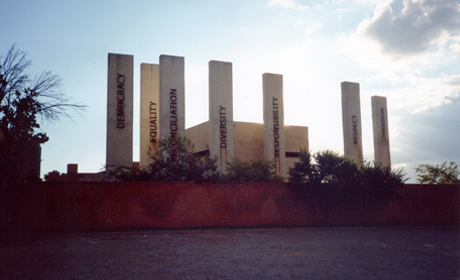The Apartheid Museum opened in 2001 and is acknowledged as the pre-eminent museum in the world dealing with 20 th century South Africa , at the heart of which is the apartheid story.
In 1995 the South African government set up a process for the granting of casino licenses, establishing an agency to do this called the Gambling Board. The bid documents stipulated that bidders should demonstrate how they would attract tourism and thereby grow the economy and stimulate job creation.
A consortium, called Akani Egoli, put in a bid that included the commitment to building a museum. Their bid was successful, the Gold Reef City casino was built and an adjacent piece of land given for the construction
The cost of the construction of what became the Apartheid Museum - approximately 80 million rand - was paid for by Akani Egoli.
The museum is registered as a Section 21 company (incorporated not for gain) with an independent board of trustees, the chairman of which is Dr John Kani. The company is separate from Akani Egoli, who has leased the museum to the Section 21 company for the duration of the casino licence. The museum therefore relies on donations, contributions and sponsorships to sustain its growth.
The Pillars of the Constitution
Between 1994 and 1996 South Africa's first fully democratic parliament, sitting as the Constitutional Assembly, drew up South Africa's new constitution. It contains guarantees of equality more extensive than anywhere else in the world. At its heart are seven fundamental values which are represented by the pillars in the first courtyard visitors encounter on arrival at the museum: democracy, equality, reconciliation, diversity, responsibility, respect and freedom.
Their liberation in 1994 with the election of Nelson Mandela, the prisoner who became president, is a climax in the saga of a nation's resistance, courage and fortitude. The Apartheid Museum , the first of its kind, illustrates the rise and fall of apartheid.
The White man is the master in South Africa, and the white man, from the very nature of his birth, and from the very nature of his guardianship, will remain master in South Africa to the end.
[House of Assembly Debates,15/3/50 col.3610]
By Eliane França


Seu trabalho ficou ótimo sobre o museu do apartheid falando dos setes pilares em um deles esta uma frase de Nelson Mandela.
ResponderExcluirJéssica Nebauer da Silva.
Inglês3 A25